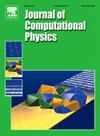New efficient data-driven reduced order models for oscillatory dynamics
IF 3.8
2区 物理与天体物理
Q2 COMPUTER SCIENCE, INTERDISCIPLINARY APPLICATIONS
引用次数: 0
Abstract
A new methodology is presented to construct data-driven reduced order models able to efficiently approximate periodic attractors of dynamical systems depending on one or more parameters. In an offline stage, some sets of temporally equidistant snapshots are computed for a limited number of parameter values. Such computation is performed using a standard numerical solver when the problem is governed by a low-dimensional system of ordinary differential equations. If, instead, the underlying dynamical system is high-dimensional (i.e., governed by partial differential equations), the snapshots are computed relying on a physics-based reduced order model obtained via proper orthogonal decomposition plus Galerkin projection. The snapshot sets are then treated using a recent, very robust data processing method, the higher order dynamic mode decomposition, which permits describing the periodic attractors as synchronized expansions in terms of spatial modes and associated temporal frequencies. Modes and frequencies are effectively interpolated at new parameter values, different from those involved in the offline stage. The online operation of the resulting data-driven reduced order model is very fast, since it requires carrying out only a small number of algebraic computations. The performance of the new method is tested for two representative dynamical systems, namely the three-dimensional Lorenz system and a high-dimensional system describing the electron transport in a semiconductor superlattice.
振荡动力学新的高效数据驱动降阶模型
提出了一种新的方法来构造数据驱动的降阶模型,该模型能够有效地逼近依赖于一个或多个参数的动力系统的周期吸引子。在脱机阶段,为有限数量的参数值计算一些暂时等距快照集。当问题由低维常微分方程系统控制时,使用标准数值求解器执行这种计算。相反,如果底层动力系统是高维的(即由偏微分方程控制),则快照的计算依赖于通过适当的正交分解和伽辽金投影获得的基于物理的降阶模型。然后使用一种最新的、非常稳健的数据处理方法——高阶动态模态分解来处理快照集,该方法允许将周期性吸引子描述为空间模态和相关时间频率方面的同步展开。模态和频率在新的参数值上得到了有效的插值,不同于离线阶段的插值。所得到的数据驱动的降阶模型的在线操作非常快,因为它只需要进行少量的代数计算。在两个具有代表性的动力学系统,即三维洛伦兹系统和描述半导体超晶格中电子输运的高维系统中,对新方法的性能进行了测试。
本文章由计算机程序翻译,如有差异,请以英文原文为准。
求助全文
约1分钟内获得全文
求助全文
来源期刊

Journal of Computational Physics
物理-计算机:跨学科应用
CiteScore
7.60
自引率
14.60%
发文量
763
审稿时长
5.8 months
期刊介绍:
Journal of Computational Physics thoroughly treats the computational aspects of physical problems, presenting techniques for the numerical solution of mathematical equations arising in all areas of physics. The journal seeks to emphasize methods that cross disciplinary boundaries.
The Journal of Computational Physics also publishes short notes of 4 pages or less (including figures, tables, and references but excluding title pages). Letters to the Editor commenting on articles already published in this Journal will also be considered. Neither notes nor letters should have an abstract.
 求助内容:
求助内容: 应助结果提醒方式:
应助结果提醒方式:


